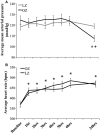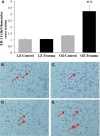A novel experimental model of orthopedic trauma with acute kidney injury in obese Zucker rats
- PMID: 24303169
- PMCID: PMC3841033
- DOI: 10.1002/phy2.97
A novel experimental model of orthopedic trauma with acute kidney injury in obese Zucker rats
Abstract
Obesity is associated with an increased risk of acute kidney injury (AKI) after blunt traumatic injury in humans. Because limitations exist in studying trauma in human patients, animal models are necessary to elucidate mechanisms of remote organ injury after trauma. We developed a model of severe orthopedic trauma in lean (LZ) and obese (OZ) Zucker rats, in which OZ develop greater kidney dysfunction after trauma than LZ. Orthopedic trauma was inflicted via bilateral hindlimb soft tissue injury, fibula fracture, and injection of homogenized bone components. Mean arterial pressure (MAP) and heart rate (HR) were measured for 6 h after trauma, and again at 24 h after trauma. Urine was collected for 24 h before and after trauma to measure urine albumin excretion. Glomerular filtration rate (GFR), renal plasma flow (RPF), plasma interleukin-6 (IL-6), and renal macrophage infiltration (ED-1 [CD68 Antibody] immunostaining) were measured in animals with and without trauma. MAP and HR were similar between LZ and OZ throughout the study, with the exception that OZ had a 18 mmHg lower pressure 24 h posttrauma. GFR and RPF were decreased significantly (∼50%), while urine albumin excretion, plasma IL-6, and renal ED-1-positive cells were increased in OZ 24 h after trauma compared to both OZ without trauma and LZ after trauma. In conclusion, these data are consistent with studies in humans that show that AKI develops more frequently in obese than in lean individuals. This model will be an important experimental tool to better understand the underlying mechanisms of poor outcomes after trauma in obese patients.
Keywords: Acute kidney injury; glomerular filtration rate; obese; orthopedic; trauma.
Figures





References
-
- Bagshaw SM, George C, Gibney RT, Bellomo R. A multi-center evaluation of early acute kidney injury in critically ill trauma patients. Ren. Fail. 2008;30:581–589. - PubMed
-
- Bellomo R, Kellum JA, Ronco C. Acute kidney injury. Lancet. 2012;380:756–766. - PubMed
-
- Belzberg H, Wo CC, Demetriades D, Shoemaker WC. Effects of age and obesity on hemodynamics, tissue oxygenation, and outcome after trauma. J. Trauma. 2007;62:1192–1200. - PubMed
Grants and funding
LinkOut - more resources
Full Text Sources
Other Literature Sources

